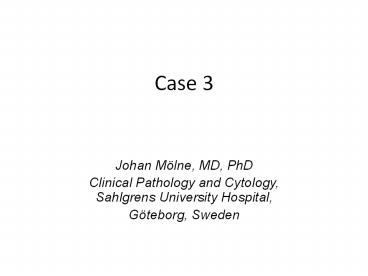Case 3 - PowerPoint PPT Presentation
1 / 25
Title:
Case 3
Description:
Electron microscopy Enlarged nuclei with irregular contours in tubular cells Diagnosis Karyomegalic tubulointerstitial nephritis Outcome After the kidney biopsy ... – PowerPoint PPT presentation
Number of Views:71
Avg rating:3.0/5.0
Title: Case 3
1
Case 3
- Johan Mölne, MD, PhD
- Clinical Pathology and Cytology, Sahlgrens
University Hospital, - Göteborg, Sweden
2
- 40 year-old woman, previously healthy presented
with acute gastroenteritis in Thailand. - When she returned to Sweden she was hospitalised
due to renal failure.
3
Clinical work-up
- S-creatinine 200 µmol/L (2 mg /dL)
- No proteinuria, microscopic hematuria.
- Slight rise in liver enzymes and CRP.
- Viral serologies (hepatitis, CMV, EBV) and
malaria tests were negative. - ANA, ANCA, anti-DsDNA and ENA were all negative.
- She had a raised blood pressure and was put on
ACE-inhibitors.
4
- Kidney ultrasound showed a small left kidney (6
cm) and a normal right kidney. - Due to unknown kidney failure a biopsy was
performed in February 2010.
5
(No Transcript)
6
(No Transcript)
7
(No Transcript)
8
(No Transcript)
9
(No Transcript)
10
(No Transcript)
11
(No Transcript)
12
(No Transcript)
13
Biopsy findings 1
- Glomeruli - normal
- 13/64 global sclerosis
- Tubuli and interstitium
- focal scarring with atrophic tubules and chronic
interstitial inflammation - lymphocytes and
plasma cells, but few eosinophils, no granuloma. - The tubular epithelial cells had giant nuclei.
The nuclei were generally irregular with focally
prominent nucleoli and course chromatin. - Arteries
- Atherosclerosis - moderate
14
Biopsy findings 2
- Immunohistochemistry
- Glomeruli - negative
- IgM and C5b-9 were seen in arterioles as in
arteriolohyalinosis. - Staining for CMV, adenovirus and polyomavirus
(SV40) negative. - Electron microscopy
- Enlarged nuclei with irregular contours in
tubular cells
15
Diagnosis
- Karyomegalic tubulointerstitial nephritis
16
Outcome
- After the kidney biopsy she was put on steroids
- Creatinine continued to rise but no improvement,
steroids were withdrawn - July 2011 - creatinine remains around 250 µmol/L
and CRP is low. She works part time and is
checked regularly
17
Discussion
- Karyomegalic changes in the tubular epithelium
- First reported in 1979 by Michael Mihatsch et al
- (observed by Burry in 1974)
- Only 20 cases reported in the literature
18
Morphology
- Marked karyomegaly in the tubular epithelium
- chronic interstitial nephritis
- Nuclear changes
- marked enlargement- up to 5-6 fold (12-26 µm)
- hyper chromatic, irregular distribution (EM)
- irregular outlines
- no inclusions
19
Pathogenesis
- Unknown
- Mutation or other genetic defect?
- Familiar clustering
- HLA clustering
- A9/B35
- Inhibition of mitosis
- Ki-67 increased in one study, normal in another
- marked DNA ploidy
20
- Karyomegalic changes in the tubular epithelium
- Associated with
- Heavy metal toxicity (nuclear inclusions)
- Busulphan therapy ?
- Cyclophosphamide ?
- Mycotoxins - ochratoxin A (mainly in pigs)
- Lithium therapy (very few enlarged nuclei)
- Viral infections (no inflammation, neg IP)
21
SV40
22
Other organs with giant nuclei
- Smooth muscle cells (intestinal, arteries)
- Schwann cells
- Bile ducts
- Liver - Kuppfer cells, fibroblasts
- Pancreas - acinar cells
- Brain - astrocytes
- Mesenchymal cells - several organs including skin
23
Clinical picture
- Progressive renal failure
- sCr 200µmol/L (2 mg/dl)
- proteinuria (0,5-1 g/24h)
- hematuria - variable
- Beginning in the third decade
- Previous infections
- often recurring, mainly involving the upper
respiratory tract - Raised liver enzymes
24
References
- 1. Mihatsch MJ et al. Clin Nephrol (1979)
1254-62 (original report) - 2. Monga G et al. Clin Nephrol (2006) 65349-355
(case and review) - 3. Spoendlin M et al. Am J Kidney Dis (1995)
25242-252 (familiar clustering) - 4. Godin M et al. Adv Nephrol (1996) 25187-211
(ochratoxin A, 2 cases) - 5. Baba F et al. Pathology Res and Pract
(2006) 202555- 559 (case) - 6. Bhandari S et al. Nephrol Dial Transplant
(2002) 171914- 1920 (6 cases)
25
Final conclusion
- Uncommon disease that is easy to recognize if you
know about it































